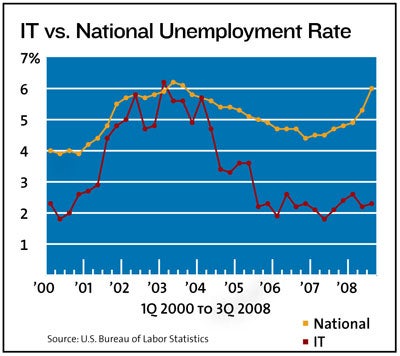
There’s no doubt that it professionals, like other Americans, will feel the distress of the worst fiscal crisis since the Great Depression. Companies are likely to shed hundreds of thousands of workers–maybe more–from their payrolls, especially in the hard-hit, IT-dependent financial services industry. But because most companies cannot function without IT, the level of unemployment among business technologists should not be as high as the level in most other occupations.
Another factor in IT’s favor: The growing deterioration of the global climate, bad as it may be for our planet and its inhabitants, should provide job opportunities in the coming years for those with critical IT skills. Government and business need to create systems and networks to more efficiently manage the distribution and use of energy.
In short, the challenges of the economy and the environment likely will create employment for people who combine IT savvy with industry or environmental know-how. “The professionals who can effectively understand two or three–or sometimes 10–different core technologies and put them together in an integrated view are going to be the winners in this new marketplace,” says Michael Valocchi, global leader for energy and utilities at IBM Global Business Services.
The responsibilities of the IT pros have continually evolved, and the trend of job convergence–where business and IT skills are a must–will only accelerate. That explains why we are unlikely to repeat the last recession (see chart at right), when IT joblessness briefly exceeded that of overall employment.
The mid-decade downturn that followed the bursting of the tech bubble had nothing to do with today’s economic woes. At that time, some 300,000 IT jobs vanished, but the losses were temporary and were regained within two years. IT job growth has been on an upward trajectory ever since, reaching record levels this year.
Society’s growing reliance on IT is clear. Technology is embedded in everything we do, and certainly in the enterprise.
From the 1960s through the 1990s, from the mainframe to enterprise computing, IT has made business more productive, and since the advent of the Internet in the mid-to-late ’90s, the ability to reduce overhead and produce revenue using IT has grown sharply. It may be an old argument, but it’s true now more than ever: Investing in IT is among the most effective ways for companies to slash costs.
IT is much more than infrastructure: It also involves the people who create and maintain this valuable technology. But as technology evolves, it is likely that IT pros may be found less and less on enterprise payrolls. Growth in IT services employment has been rocketing in recent years, so many IT professionals are likely to find themselves working for services types of firms instead of end-user organizations. Similarly, with the growth of software as a service and other forms of cloud computing–far from mature industries–IT pros will find themselves working for those types of companies, which will service their current employers.
But IT isn’t s
Among the greatest challenges we face are global warming and the need not only to discover alternatives to fossil fuels, but also to create a smart, IT-based grid to more effectively use energy and manage its distribution.
That could involve the employment of tens of thousands of U.S.-based IT-skilled professionals. In his current best-seller–Hot, Flat and Crowded: Why We Need a Green Revolution and How It Can Renew America (Farrar, Straus & Giroux)–Thomas Friedman sees the fusion of IT and energy technologies creating this new Internet.
Friedman envisions “all the power systems in your home … communicating with all the information systems in your home and that they had all merged into one big seamless platform for using, storing, generating, and even buying and selling clean electronics. It would feel like the information technology revolution and the energy technology revolution, IT and ET, had merged into a single system … an Energy Internet.”
Recession or not, Friedman says the world has no choice but to move toward the Energy Internet–not only for environmental reasons, but for economic and geopolitical reasons as well.
And professionals with IT skills will be needed to build integral components of the clean-energy Web.